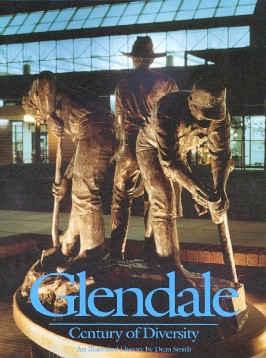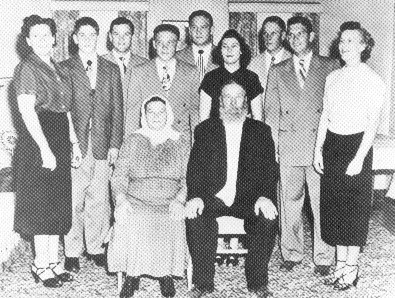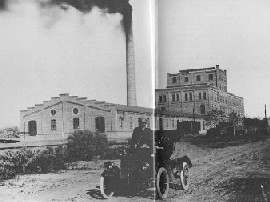 |
Glendale Century of Diversity An illustrated history by Dean Smith Celebrating the Glendale Centennial: Chapter 2: The Convergence of Cultures — Pages 34-36 — [Among stories of Glendale's diverse founding nationalities (Chinese, Basque, Japanese, Hispanic, German, etc) and religions (Catholic, Baptist, Methodist, etc.) is this page about the Russian Molokans.] |
| One of the unique hallmarks of
Glendale is its
Russian community, first lured to Arizona with the promise
of land and
the freedom to practice their Spiritual
Christian faiths Molokan religion.
The Pryguny Molokans ("Milk
Drinkers" "Jumpers" in Russian) were a dissident group
which broke from the
Russian Orthodox Church and were much influenced by the Mennonite Jumpers and
Quakers.
The first members of the Russian colony arrived from California by train in 1911 and settled on farms some two miles west of the Glendale townsite. There were Tolmachoffs and Popoffs; Treguboffs, Kulikoffs and Conovaloffs; the men wearing long beards and the women shrouded in ankle-length dresses. They were brought to Glendale by the Greene and Griffin real estate firm, which had arranged for the Russians to pay for their land partly in cash and partly in the sugar beets they grew for processing in Glendale's Beet Sugar Factory. |
 As a part of the Russian migration in 1911, the Treguboffs played a valued part in the Russian community as well as in Glendale's agricultural community. Courtesy, Treguboff Collection
|
| [* Omitted: Gozdiff, Papin,
Prohoroff, Shubin,
Teckenoff, Uraine and Veronin
families which remain in 1990.
The original 200 families include
Valov, Pivovaroff, Galitzen, Rudometkin, Kotoff,
Mendrin,
Slevkoff, Bogdanoff, Susoeff, ...]
One of the largest parties of settlers ever brought into the Salt River valley started from Los Angeles at 2 o'clock this afternoon over the Santa Fe, bound for Glendale. In the party are about 170 adult Russians, together with the members of their families, all eager to reach the land of promise and of health. Numbered among the men of the party are farmers, carpenters, painters, blacksmiths, and common laborers ... they will find ready employment when not engaged in tilling their own soil. Arizona Gazette |
The Russian
immigrants did not mix
readily at first with Glendale residents, and their
unfamiliar language
and customs
and religion made assimilation difficult. But their ways
were
eventually accepted, and soon they became an integral part
of the
community. Approximately 20 families remain in Glendale
today.
Alex Popoff and Jim Treguboff were famed athletes at
Glendale
Union High School, and many others made their marks. Nationally famous
athletes include Olympic diver Michael
Galitzen, his
brother AAU diver Johhny Galitzen, and baseball player
Lou
Novikoff. Mary
Tolmachoff
married noted developer John F. Long, who named his
planned community
of Maryvale (now a part of both Glendale and Phoenix)
after his wife and
donated land for the Glendale Airport among many
contributions. |
 |
Chapter 3: From Farmlands to Smokestacks —
Page
38
The Beet Sugar Factory is seen here from the south, ca. 1910. Its opening in 1906* was greeted with great excitement through our the area, but the plant experienced only limited success during the decade it operated. ... The smokestack was removed in 1951 after it was hit by lightning. Courtesy, Glendale Arizona Historical Society. |
| * As railroads
were built across the west since the late 1800s, the sugar
industry actively recruited immigrating colonist farmers
to work sugar beet and cane fields. Agents and owners
tried recruiting Russian Spiritual Christians in Hawaii,
California and other states prior to the Arizona
contracts. The most zealous Russian leaders also signed an
option to buy ALL the west valley land needed to grow ALL
the beets required, then he lobbied more families from Los
Angeles. By 1920, there were 4 adjacent
Spiritual Christian villages between Glendale and
Tolleson with a population as high as 1000. |
|
More on the history of Glendale by Jeffrey Scott